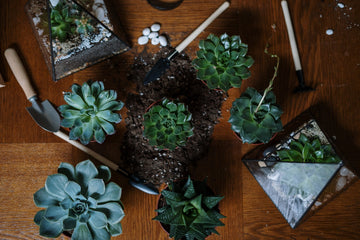Welcome to the fascinating world of succulent terrariums! If you're looking for a creative, low-maintenance way to bring nature indoors and transform your living space into a trendy sanctuary, then this beginner's guide is tailor-made for you. In this step-by-step tutorial, we'll walk you through the mesmerizing process of crafting a stunning succulent terrarium that will effortlessly breathe life into any room. So grab your gardening gloves and prepare to embark on an exciting journey of unleashing your inner artist while creating an eye-catching oasis that everyone will envy!
Step-by-Step Guide to Creating Your Own Succulent Terrarium:
Creating your own succulent terrarium is a fun and easy way to add some greenery to your home décor. Not only are they beautiful, but they also require minimal maintenance, making them the perfect plant for those with busy schedules or not-so-green thumbs.
To help you get started on this crafty venture, we have put together a step-by-step guide on how to build your own stunning succulent terrarium. With just a few materials and some simple steps, you will have a gorgeous mini-ecosystem that will be the envy of all your friends.
Step 1: Gather Materials
The first step in creating any project is gathering all the necessary materials. For this project, you will need:
- A glass terrarium container (can be found at most home improvement or gardening stores)
- Succulent plants of various sizes (2-5 plants depending on the size of your terrarium)
- Cactus/succulent potting mix
- Decorative rocks/pebbles
- Sphagnum moss
- Activated charcoal
- Small shovel/hand trowel
Step 2: Prepare Your Terrarium Container
Before starting to assemble your terrarium, it's important to make sure that the container is clean and free of any dirt or debris. You can use warm water and soap to wash the inside of the container thoroughly.
Once it's clean and dry, start by adding a layer of decorative rocks or pebbles at the bottom. This helps with drainage and prevents water from pooling at the bottom of your terrarium.
Step 3: Add a Layer of Sphagnum Moss
Now add a layer of sphagnum moss on top of the pebbles. The moss is beneficial for absorbing water and maintaining the plants' moisture levels. It is also useful for creating a barrier between terrariums to prevent soil from seeping into the drainage layer.
Step 4: Add a Layer of Activated Charcoal
Next, add a layer of activated charcoal on top of the rocks. This will help with filtering the water and keeping it clean for your succulents.
Step 5: Add Potting Mix
Now it's time to create a bed for your succulents to grow in. Carefully add a layer of cactus/succulent potting mix on top of the charcoal. Make sure that the soil is evenly distributed and level.
Step 6: Plant Your Succulents
Using your hands or a small shovel/trowel, make holes in the soil where you want to place your succulents. Gently remove the succulent plants from their containers and loosen their roots before placing them in the holes.
Fill any remaining gaps with more potting mix and gently press down around each plant to secure them in place.
Step 7: Add More Decorative Stones
After all your plants are securely planted, add another layer of decorative stones on top of the soil. This not only adds visual interest but also helps prevent any excess moisture from getting onto your succulents.
Step 8: Water Your Terrarium
Give your terrarium a good watering, making sure that the soil is damp but not soggy. Succulents do not like to be overwatered, so it's important to only water them when the soil is dry.
Step 9: Place Your Terrarium in a Bright and Indirect Sunlight Spot
Succulents thrive in bright, indirect sunlight. Find a spot for your terrarium where it can get plenty of light without being directly exposed to the harsh rays of the sun.
Step 10: Maintenance and Care
Succulents are low-maintenance plants, but they still require some care to thrive. Make sure to monitor the moisture in the soil and only water when necessary. You can also use a spray bottle to mist your succulents occasionally.
Trim off any dead or dying leaves as needed, and rotate your terrarium every few weeks to ensure even growth.
Congratulations! You have successfully created your own beautiful succulent terrarium. With proper care and maintenance, your mini-ecosystem will continue to grow and bring life into your home décor.
Tips for Choosing the Right Container and Soil
Choosing the right container and soil are essential steps in creating a successful succulent terrarium. The container and soil you use will not only impact the overall appearance of your terrarium but also play a crucial role in the health and growth of your succulent plants.
Container:
When it comes to choosing a container for your succulent terrarium, there are several options available. You could go for traditional glass or ceramic containers, or you could get more creative with unique containers like mason jars, fishbowls, or even old tea cups. The key is to choose a container that provides enough space for your succulents to grow while also allowing for proper drainage.
In terms of size, it's best to choose a container that is at least 2-3 inches deep so that the roots of your succulents have enough room to spread out. Additionally, make sure that the opening of your chosen container is wide enough for you to easily fit your hands and tools inside when planting.
Soil:
Succulents need well-draining soil to thrive as they are susceptible to root rot if their roots sit in water for too long. Regular potting soil tends to hold onto moisture, which can be harmful to succulents. It's best to opt for a special mix specifically made for cacti and succulents, which contain ingredients like perlite or sand that help improve drainage.
If you cannot find pre-made cactus or succulent soil mix, you can make one yourself by mixing equal parts of potting soil, coarse sand, and perlite or pumice. This mix will provide the right balance of nutrients, aeration, and drainage for your succulent terrarium.
It's important to remember not to use garden soil in your terrarium as it is too dense and retains too much moisture, which can lead to root rot.
In summary, when choosing a container and soil for your succulent terrarium, prioritize those with good drainage and opt for special cactus or succulent soil mix whenever possible.
Tips for Caring for Your Succulent Terrarium:
As a low-maintenance and visually appealing addition to any home, succulent terrariums have become a popular choice for plant lovers. While they may seem easy to care for, there are some important tips to keep in mind in order to ensure the success and long-term health of your terrarium.
1. Planting Techniques
When planting your succulents in the terrarium, fill the bottom layer with about an inch of small rocks or pebbles before adding in the soil mixture on top. This will help in creating proper drainage and prevent root rot. Gently loosen up the roots of each plant before placing them into the soil to promote healthy growth .
2. Watering
One of the most common mistakes when caring for succulent terrariums is over-watering. These plants are drought-resistant and do not require frequent watering. The best way to determine when it needs water is to stick your finger a few inches into the soil – if it feels dry, then it’s time to water. Be sure to water the soil directly rather than spraying the plants. Water sparingly, about once a week or less depending on the humidity and temperature of your home.
3. Proper Lighting
Succulents need plenty of bright, indirect sunlight in order to thrive. Place your terrarium near a window or other source of natural light, but make sure it is not getting direct sunlight as this can cause sunburn on the leaves.
4. Pruning and Maintenance
Pruning your succulents regularly will help them maintain their shape and prevent them from overcrowding in the container. Use sharp scissors or pruning shears to remove any dead or damaged leaves and stems.
5. Fertilizing
Succulents don’t require much fertilizer, but adding some during their active growth period (usually spring and summer) can help promote healthy growth. Use a balanced fertilizer diluted to half strength every few months.
6. Temperature and Humidity
Succulents prefer warm and dry conditions, so make sure to keep your terrarium in a room with consistent temperatures and good air circulation. Avoid placing it near any drafts or vents which can dry out the soil too quickly.
By following these tips, you can enjoy a beautiful and healthy succulent terrarium for years to come. Remember to adjust your care routine based on the specific needs of your plants and continue to monitor their growth and health regularly.

